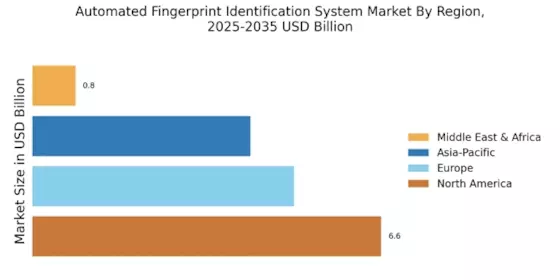Regulatory Mandates
The Automated Fingerprint Identification System Market is significantly influenced by regulatory mandates that require the implementation of biometric identification systems. Various governments are enacting laws and regulations that necessitate the use of fingerprint recognition for identity verification in sectors such as immigration, law enforcement, and financial services. For example, the implementation of stricter Know Your Customer (KYC) regulations in the banking sector has led to an increased reliance on biometric systems to verify customer identities. This regulatory push is likely to drive the adoption of automated fingerprint identification systems, as organizations seek to comply with legal requirements while enhancing their security protocols. Consequently, the market is expected to expand as more entities integrate these systems into their operations.
Technological Innovations
The Automated Fingerprint Identification System Market is experiencing a surge in technological innovations that enhance the accuracy and efficiency of fingerprint recognition. Advancements in artificial intelligence and machine learning algorithms are enabling systems to process and analyze fingerprint data with unprecedented speed and precision. For instance, the integration of deep learning techniques has shown to improve the matching accuracy rates significantly, potentially exceeding 99%. Furthermore, the development of mobile fingerprint scanning devices is expanding the accessibility of these systems, allowing for real-time identification in various settings. As organizations increasingly adopt these advanced technologies, the demand for automated fingerprint identification systems is likely to grow, reflecting a broader trend towards automation and digital transformation across multiple sectors.
Heightened Security Concerns
In an era marked by escalating security threats, the Automated Fingerprint Identification System Market is witnessing heightened demand driven by the need for robust security solutions. Governments and private organizations are increasingly investing in biometric technologies to safeguard sensitive information and ensure public safety. According to recent data, the biometric market is projected to reach a valuation of over 50 billion dollars by 2025, with fingerprint recognition systems constituting a substantial portion of this growth. The ability of automated fingerprint identification systems to provide reliable and tamper-proof identification is appealing to sectors such as law enforcement, banking, and healthcare. As security concerns continue to mount, the adoption of these systems is expected to rise, further propelling the market forward.
Growing Adoption in Various Sectors
The Automated Fingerprint Identification System Market is witnessing a growing adoption across diverse sectors, including healthcare, finance, and travel. In healthcare, for instance, hospitals are increasingly utilizing fingerprint identification systems to streamline patient registration and ensure accurate medical records. Similarly, financial institutions are implementing these systems to enhance security measures and prevent fraud. The travel industry is also leveraging fingerprint recognition for efficient passenger processing at airports. This cross-sector adoption indicates a broader recognition of the benefits offered by automated fingerprint identification systems, such as improved efficiency and enhanced security. As more industries recognize the value of biometric solutions, the market is poised for continued growth.
Increased Investment in Biometric Technologies
The Automated Fingerprint Identification System Market is benefiting from increased investment in biometric technologies, as both public and private sectors recognize the potential of these systems. Venture capital funding and government grants are being directed towards the development of innovative biometric solutions, including advanced fingerprint recognition systems. This influx of capital is fostering research and development efforts, leading to the creation of more sophisticated and user-friendly systems. As investment continues to flow into the biometric sector, it is likely that the capabilities of automated fingerprint identification systems will expand, making them more appealing to a wider range of applications. This trend suggests a promising future for the market, as enhanced technologies emerge to meet the evolving needs of various industries.

















Leave a Comment